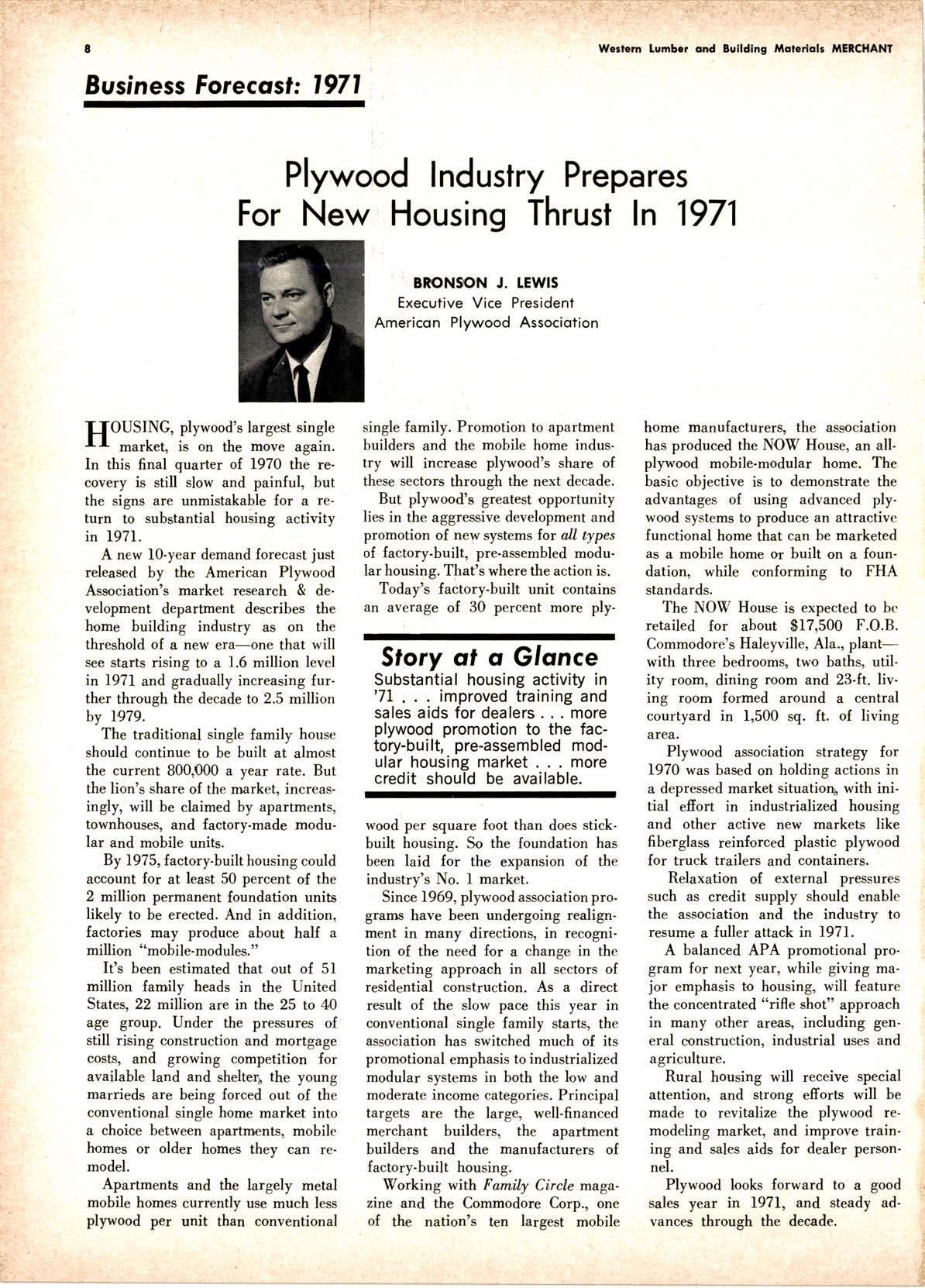
2 minute read
Plywood Industry Prepares For New Housing Thrust In 1971
ERONgON J. LEWIS Executive Vice Presidenf Americon Plywood Associotion
EIOUSING, plywood's largest single tr market, is on the move again. In this final guarter oI 1970 the recovery is still slow and painful, but the signs are unmistakable for a return to substantial housing activity in 197I.
A new l0-year demand forecast just releasecl by the American Plywood Association's market research & development department describes the home building industry as on the threshold of a new era-one that will see starts rising to a 1.6 million level in l97I and gradually increasing further through the decade to 2.5 million by 1979.
The traditional single family house should continue to be built at almost the current 800,000 a year rate. But the lion's share of the market, increasingly, will be claimed by apartments, townhouses, and factory-made modular and mobile units.
By 1975, factory-built housing could account for at least 50 percent of the 2 million permanent loundation units likely to be erected. And in addition, factories may produce about half a million "mobile-modules."
It's been estimated that out of 5l million farnily heads in the United States, 22 million are in the 25 to 4A age group. Under the pressures of still rising construction and mortgage costs, and growing competition for available land and shelteq the young marrieds are being forced out of the conventional single home market into a choice between apaxtments, mobile homes or older homes they can re. model.
. Apartments and the largely metal mobile homes currently use much less plywood per unit than conventional single family. Promotion to apartment builders and the mobile home industry will increase plywood's share of these sectors through the next decade. But plywood's greatest opportunity lies in the aggressive development and promotion of new systems for all types of factory-built, pre-assembled modular housing. That's where the action is. Todayls factory-built unit contains an average of 30 percent more ply-
Story si q Glonce
Substantial housing activity in '7I, . . improved training and sales aids for dealers . . more plywood promotion to the factory-built, pre-assembled modular housing market . . . more credit should be available.
wood per square foot than does stickbuilt housing. So the foundation has been laid for the expansion of the industry's No. I market.
Since 1969, plywood association prograrns have been undergoing realiglment in many directions, in recognition of the need for a change in the marketing approach in all sectors of residential construction. As a direct result of the slow pace this year in conventional single family starts, the association has switched much of its promotional emphasis to industrialized modular syst€ms in both the low and moderate income categories. Principal targets are the large, well-financed merchant builderso the apartment builders and the manufacturers of factory-built housing.
Working with Family Circle magazine and the Commodore Corp., one of the nation's ten largest mobile home manufactulsls, the association has produced the NOW House, an allplywood mobile-modular home. The basic objective is to demonstrate the advantages of using advanced plywood systems to produce an attractive functional home that can be marketed as a mobile home or built on a foundation, while conforming to FHA standards.
The NOW House is expected to bc retailed for about $17,500 F.O.B. Commodore's Haleyville, Ala., plant-with three bedrooms, two baths, utility room, dining room and 23-ft. living room formed around a central courtyard in 1,500 sq. ft. of living area.
Plywood association strategy for 1970 was based on holding actions in a depressed market situations with ini tial efiort in industrialized housing and other active new markets like fiberglass reinforced plastic plywood for truck trailers and containers.
Relaxation of external pressures such as credit supply should enable the association and tJre industry to resume a fuller attack in 1971.
A balanced APA promotional program for next year, while giving major emphasis to housing, will feature the concentrated "rifle shot" approach in many other areas, including general construction, industrial uses and agriculture.
Rural housing will receive special attention, and strong efforts will be made to revitalize the plywood remodeling market, and improve training and sales aids for dealer personnel.
Plywood looks forward to a good r{ sales year in 1971, and steady advances through the decade.









